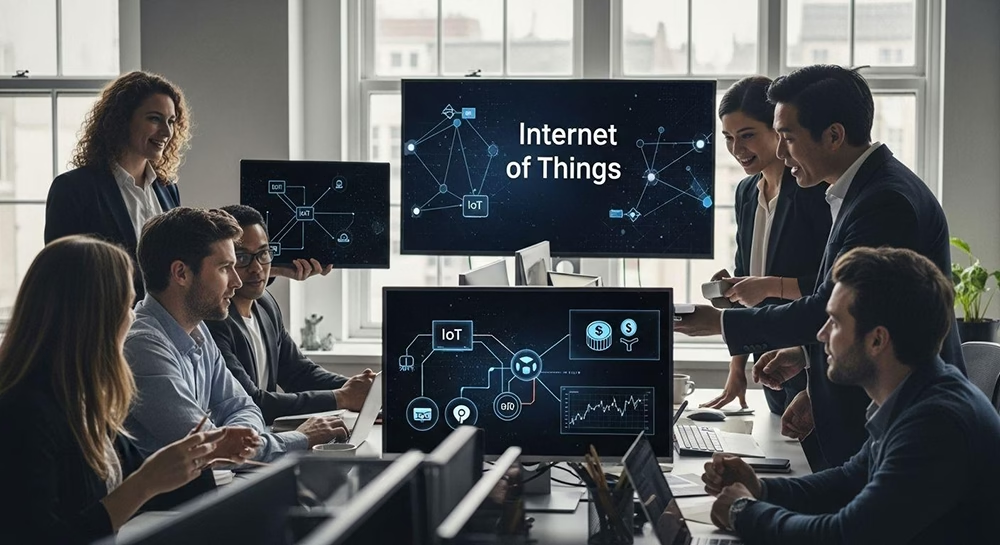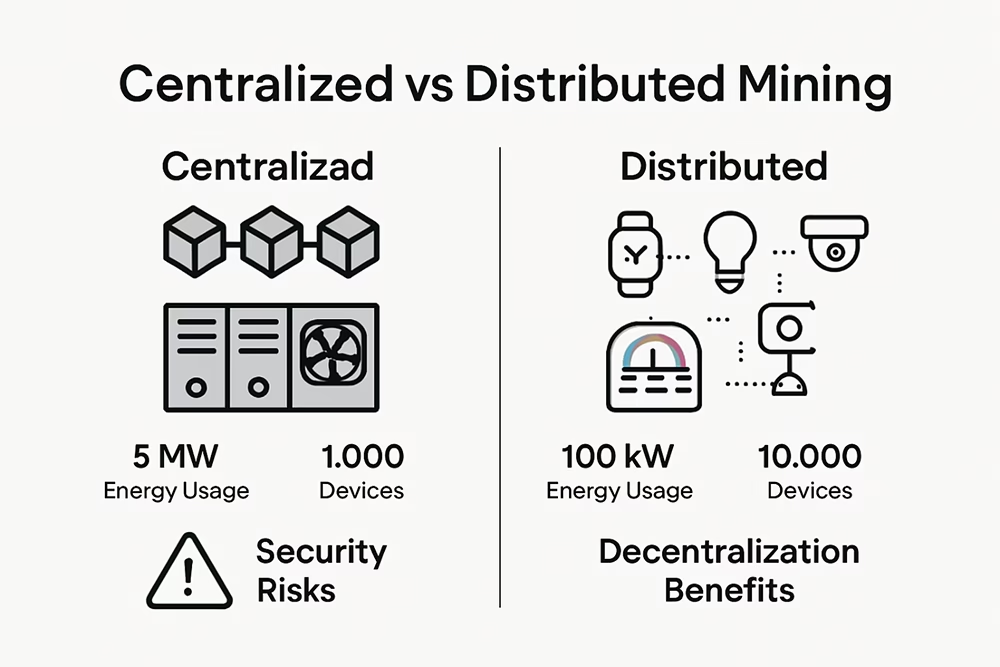
Everyone talks about how the Internet of Things connects your fridge or your watch, but the real power lies far beyond smart homes. Imagine this—IoT innovation is making cryptocurrency mining more accessible and energy-efficient than ever, with even basic home devices joining blockchain networks. Most people still think of IoT as wireless gadgets and disconnected sensors, yet its biggest disruption is rewriting the rules of finance and crypto from the inside out.
| Takeaway | Explanation |
|---|---|
| IoT enhances cryptocurrency mining efficiency. | By utilizing distributed networks of IoT devices, mining becomes more accessible and energy-efficient. |
| IoT transforms financial market analysis. | Real-time data from IoT devices provides updated insights for quicker and more informed investment decisions. |
| Smart contracts can be automated with IoT. | IoT sensors can trigger trades based on real-world conditions, streamlining the trading process. |
| IoT presents unique cybersecurity challenges. | Weak security in IoT devices can lead to vulnerabilities such as cryptojacking, requiring robust defense mechanisms. |
| Effective risk management is crucial in IoT ecosystems. | Organizations must adopt comprehensive security strategies and protocols to protect digital assets from evolving threats. |
The Internet of Things (IoT) is revolutionizing cryptocurrency mining by introducing unprecedented levels of connectivity, efficiency, and distributed computing power. Bitcoin mining traditionally required specialized hardware in centralized facilities, but IoT technologies are fundamentally reshaping this landscape.
IoT devices are emerging as potential distributed mining resources. Research from scientific publications demonstrates that even low-power microcontrollers can contribute to cryptocurrency mining algorithms. This decentralized approach allows multiple small devices to collectively generate computational power, creating a more resilient and accessible mining ecosystem.
Unique IoT mining strategies include utilizing device idle processing time. A recent patent outlines a system where networked IoT devices can pool their computational resources during periods of low activity. These innovative approaches challenge traditional mining models by transforming everyday connected devices into potential mining nodes.
However, IoT mining is not without risks. Scientific American reports that IoT devices often have weak security configurations, making them vulnerable to cryptojacking. Malicious actors can hijack these devices to mine cryptocurrencies without owner consent, presenting significant ethical and technical challenges.
Mitigating these risks requires robust security protocols, including advanced encryption, continuous device monitoring, and user authentication mechanisms. As IoT mining technologies evolve, developing comprehensive security frameworks becomes paramount to protecting both individual users and broader network infrastructures.
To clarify the main opportunities and challenges of IoT-powered crypto mining, the table below summarizes how IoT changes mining and the associated considerations.
| Aspect | Traditional Mining | IoT-Powered Mining |
|---|---|---|
| Hardware | Specialized, high-power rigs | Everyday connected devices, low-power microcontrollers |
| Mining Model | Centralized | Decentralized/Distributed |
| Accessibility | Limited to professionals | Accessible to anyone with IoT devices |
| Energy Usage | Very high | Potentially more efficient |
| Security Risks | Well-understood, managed | High risk—prone to cryptojacking and weak device security |
The convergence of IoT and cryptocurrency mining represents a transformative technological frontier. By distributing computational workloads across diverse device networks, miners can potentially reduce energy consumption, increase network resilience, and democratize mining participation. Learn more about our mining research to understand how these emerging technologies are reshaping the cryptocurrency landscape.
As blockchain technologies continue advancing, IoT devices will likely play an increasingly sophisticated role in cryptocurrency ecosystems. The ability to leverage millions of connected devices for distributed computing could fundamentally alter how we conceptualize and implement cryptocurrency mining strategies in the coming years.

The Internet of Things (IoT) is rapidly transforming financial markets by introducing unprecedented data collection and real-time analytics capabilities. Beyond traditional financial monitoring, IoT technologies are creating sophisticated networks that enable more precise, instantaneous market insights and risk management strategies.
Data-Driven Financial Intelligence
Research in Financial Innovation reveals how big data generated by IoT devices can revolutionize capital market analysis. Financial institutions can now leverage sensor networks and connected devices to gather granular economic information, transforming how investment decisions are made.
Sensors embedded in industrial equipment, supply chains, and infrastructure provide real-time performance metrics that directly impact stock valuations. For instance, IoT sensors monitoring manufacturing output can offer immediate insights into company performance, allowing traders and investors to make more informed decisions with unprecedented speed and accuracy.
The Journal of Sensors highlighted the critical role of wireless sensor networks and RFID technologies in enhancing financial transparency. These IoT technologies enable precise tracking of goods, inventory, and logistical movements, providing financial analysts with comprehensive data streams that were previously unavailable.
By integrating IoT sensors across supply chains, financial institutions can assess risk more effectively, predict potential disruptions, and develop more robust investment strategies. Real-time monitoring allows for immediate identification of potential economic challenges or opportunities, fundamentally changing risk assessment methodologies.
The convergence of IoT and financial technologies is creating entirely new economic ecosystems. Connected devices are not just data collectors but are becoming integral components of financial infrastructure. Smart contracts, blockchain technologies, and automated trading systems increasingly rely on IoT-generated data to execute complex financial transactions.
Explore our research on technological financial innovations to understand how these emerging technologies are reshaping economic landscapes. As IoT continues to evolve, we can expect increasingly sophisticated financial models that leverage real-time, globally distributed data networks.
The future of finance is interconnected, with IoT serving as a critical infrastructure that enables more transparent, efficient, and responsive economic systems. By transforming raw data into actionable insights, IoT technologies are not just changing how we understand financial markets but are redefining the very mechanics of global economic interactions.
The following table provides a quick overview of how IoT enhances various aspects of finance and financial market operations, as detailed in the section above.
|
Financial Application |
Role of IoT Technology |
Benefit/Outcome |
|
Market Analysis |
Real-time sensor and device data |
Faster, more informed investment decisions |
|
Supply Chain Risk Assessment |
End-to-end tracking with sensors and RFID |
Transparent monitoring, improved predictions |
|
Smart Contract Execution |
IoT-triggered blockchain transactions |
Automated, condition-based trading |
|
Algorithmic Trading |
Trusted, verified sensor data streams |
Enhanced algorithmic strategies |
|
Risk Management & Compliance |
Granular, real-time monitoring of operations |
Better compliance and immediate alerts |
The integration of Internet of Things (IoT) technologies is creating transformative opportunities for cryptocurrency traders, enabling more sophisticated, data-driven trading strategies that leverage real-time information from interconnected devices and sensors.
Smart Contract Automation with IoT Data
The European Commission research reveals groundbreaking applications where IoT sensors directly trigger blockchain-based smart contracts. Imagine cryptocurrency trades automatically executed based on specific real-world conditions such as commodity prices, logistical movements, or environmental metrics.
For instance, a crypto trader could establish a smart contract that automatically purchases a specific cryptocurrency when IoT sensors detect a particular supply chain efficiency or manufacturing output. This approach transforms traditional trading by introducing direct, verifiable connections between physical world events and financial transactions.
NIST research highlights the critical role of trusted IoT data streams in creating transparent, verifiable financial ecosystems. Cryptocurrency traders can now access immutable, blockchain-verified sensor data that provides unprecedented insights into global economic conditions.
These IoT-generated data streams enable more nuanced algorithmic trading strategies. Traders can develop complex trading algorithms that respond to real-time information from global sensor networks, covering everything from agricultural production to industrial output. The ability to integrate verified, instantaneous data transforms risk assessment and investment decision-making.
IoT technologies are revolutionizing risk management for cryptocurrency traders by providing granular, real-time monitoring capabilities. Connected devices can track multiple economic indicators, supply chain movements, and regulatory compliance metrics, offering traders comprehensive insights that were previously impossible to obtain.
Explore our advanced trading research to understand how emerging technologies are reshaping cryptocurrency trading strategies. The future of crypto trading lies in leveraging interconnected technologies that provide immediate, verifiable information across global networks.
As IoT continues to evolve, cryptocurrency traders will increasingly rely on these sophisticated data ecosystems. The ability to make instantaneous, data-driven decisions based on real-world sensor information represents a fundamental shift in how we conceptualize financial trading in the digital age. By bridging physical and digital worlds, IoT is creating a more transparent, efficient, and responsive financial ecosystem.
The integration of Internet of Things (IoT) technologies into cryptocurrency ecosystems introduces complex security challenges that demand sophisticated, multifaceted risk management strategies. As interconnected devices become increasingly prevalent in financial technologies, understanding their potential vulnerabilities becomes crucial for protecting digital assets and maintaining system integrity.
Cybersecurity Threat Landscape
A Congressional report on IoT cybersecurity highlights the significant risks associated with IoT device integration in financial systems. These devices can potentially serve as entry points for malicious actors, enabling distributed denial-of-service (DDoS) attacks that could compromise crypto exchanges and disrupt financial transactions.
Cryptocurrency platforms must develop robust security protocols that anticipate and mitigate potential vulnerabilities. This includes implementing advanced encryption, continuous monitoring systems, and sophisticated authentication mechanisms that can protect against emerging cyber threats specific to IoT environments.
Research from ACM Transactions on Internet of Things reveals multiple sophisticated attack strategies targeting IoT devices in financial ecosystems. These include man-in-the-middle attacks, where unauthorized parties intercept communication between devices, and data tampering techniques that can manipulate sensor-generated information.
Particularly concerning are network eavesdropping methods that exploit weak authentication protocols. Crypto traders and financial institutions must invest in endpoint protection strategies that go beyond traditional cybersecurity approaches. This involves developing adaptive security architectures that can dynamically respond to evolving threat landscapes.
Effective IoT security in crypto ecosystems requires a comprehensive approach that combines technological solutions with strategic governance. Organizations must implement multi-layered security frameworks that include regular vulnerability assessments, real-time threat detection, and rapid incident response protocols.
Learn more about our comprehensive security research to understand the cutting-edge strategies protecting digital financial infrastructures. Key mitigation strategies include implementing zero-trust security models, utilizing blockchain-based authentication mechanisms, and developing advanced encryption techniques specifically designed for IoT environments.
As cryptocurrency and IoT technologies continue converging, security will remain a critical priority. The most successful platforms will be those that can seamlessly integrate innovative technologies while maintaining rigorous protection against emerging cyber threats. By anticipating potential vulnerabilities and developing proactive defense mechanisms, the crypto industry can harness the transformative potential of IoT while safeguarding digital assets and user trust.

IoT enhances cryptocurrency mining by allowing everyday connected devices to participate in decentralized mining networks, making the process more accessible and energy-efficient.
IoT devices are often vulnerable to attacks like cryptojacking due to weak security configurations, which can lead to unauthorized mining and other cyber threats.
IoT provides real-time data from various sensors and devices, allowing financial institutions to make quicker, data-driven investment decisions based on up-to-date information.
IoT can trigger smart contracts based on real-world conditions, enabling automatic execution of trades when specific criteria are met, facilitating a more responsive trading approach.
The article highlights how the growth of IoT is making Bitcoin mining more accessible yet riskier. You might be excited about the potential for distributed mining through IoT devices, but also concerned about complicated setups, inefficient returns, and critical security gaps like cryptojacking.
Imagine a world where you can start mining instantly, with every technical and security detail handled by proven experts. Stop worrying about weak device security or missing out on energy-efficient breakthroughs. With Blockware Solutions, you get full concierge support, enterprise-grade hardware, and ROI tracking tailored for both newcomers and advanced miners.

Ready to see how effortless and secure hosted mining can be? Get started today on the path toward smarter, safer, and more profitable Bitcoin mining. Discover all the options and services we offer at our homepage. Let us help you harness the next phase of mining innovation. Act now and unlock your edge in the evolving IoT and crypto landscape.